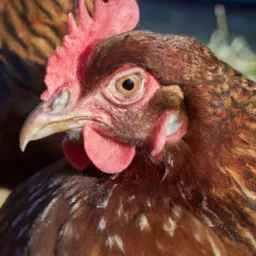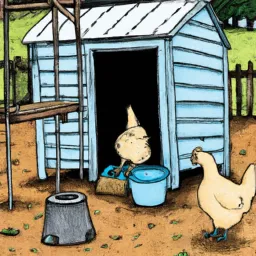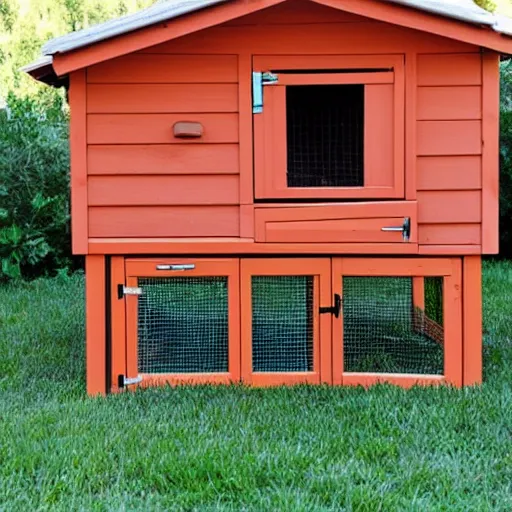The 7 Things Your Chicken House Plans Must Provide
When it comes to chicken house plans, no matter what chicken coop design you have decided to build the ideal chicken house must provide the following in order to keep your pet chickens happy and healthy.
Here we are going to have a look at the seven things that you should keep in mind when looking at chicken coop designs.
1. Chicken House Plans And Space
No one likes to be jam-packed into any one tiny room, you know what it’s like, you need your space and this is no different for your pet chickens.
Your chickens will need enough room so that they can easily spread their wings and move around in some comfort.
Generally speaking, you should allow about 4 sq. ft (0.4 square meters) per full-grown chicken.
Now you also need to consider if you are going to get bantams – the smaller chicken variety, or bigger breeds of chickens.

So reconsider how much space they will need.
2. Protection From Predators
The chicken coop that you buy or build not only acts as a shelter against the elements for your chickens it should also protect your chickens from predators.
And…
There are always predators no matter what country you live in…
Even if you think that you don’t have any predators in your area think again.
Once you have filled your coop with chickens you would be surprised at what animal would like to have their chance at an easy meal such as a flightless bird.
Depending on where you live you could have predators such as possums, goannas, raccoons, foxes, coyotes, foxes, dingoes wild dogs, snakes, hawks, and other larger birds of prey.
You should also consider protecting your chickens against other pets like your dogs or cats they all love chasing birds and the chase does not always end nicely.
3. Lighting
Sufficient natural lighting is important to chickens in your chicken house plans, as they need around fourteen hours of sunlight every day.
Just like ourselves, light is an integral part of life and your chickens don’t want to be walking into a dark chicken house, no more than you like walking into your own house that has no lighting…
It’s just natural.
Natural light inside the chicken coop can come from a doorway, windows, or even a skylight if you want to get fancy…
4. Shelter From The Elements
Your chicken coop must provide your chickens with a dry place to shelter when it’s raining or snowing in the cooler weather.
And shade for when it’s hot, basically it must offer them protection no matter what the weather conditions are in your area.
Come hail or shine…
5. Ventilation In Your Chicken Coop
Fresh air must be allowed to circulate freely in order to keep your chicken’s respiratory health in order.
See also Chicken Coop Plans - Sketch Plans For A Simple Chicken Coop
You see ammonia can quickly build up inside a coop from the chicken droppings and if the coop is not well-ventilated the ammonia vapors can cause problems to the chicken’s health.

If you don’t know already chicken poop is quite strong, and apart from getting on your fingers for instance…
As I well know, it’s hard to get the smell off even after washing.
It does go away though…
A well-ventilated area also prevents mold and mildew from occurring.
This is from the chicken manure and general mildew from the hay or wood shavings that you might have in the coop itself.
6. Easy To Clean
Keeping chickens does mean that now, and then you will need to get into the coop can give it a good clean.
There is nothing worse than getting down on your knees trying to get into those tiny crevices to get rid of chicken house bedding that has served its time and all those droppings of course…

So think about this now before you build your coop you can have concrete floors, wire mesh, linoleum/vinyl, timber, or dirt it’s really up to you.
But to make cleaning easier you could add wood shavings, sawdust, fine landscaping mulch, sand, or horse bed
ding which all can easily be scooped out and used as mulch for your garden.
Don’t forget the garden, it loves this sort of chicken compost.
7. Temperature Control
Depending on where you may live in the world you may not have to consider temperature control.
Chicken’s do best in temperatures of about 40 to 85 degrees Fahrenheit (5 to 30 degrees Celsius).
So if your area is prone to very cold winters or very long hot summers you may want to consider some type of temperature control inside the coop.'
Some have even gone as far as making knitted chicken coats.
Yes!
I cannot say I have done this, but they are being knitted most probably as we speak in some parts of the world to keep their chickens warm in the coldest of days and also nights of course.
Well…
When it comes to the most important chicken house plans and the designs you need to add on, to keep your chickens as happy and healthy as possible.
How Far From House Should Chicken Coop Be? And Other Poultry Ponderings
The Great Chicken Coop Distance Debate
Ah, the chicken coop…
A haven for our feathered friends and a source of endless entertainment for us humans.
But when it comes to deciding the optimal distance between your house and the coop, it’s not as simple as measuring it with a chicken-sized ruler.
See also Chicken Nest Box Dilemma! Where Are The Eggs?
The Neighborly Squabble
Let’s start with the neighborly aspect. The last thing you want is your chickens clucking up a storm right outside your neighbor’s bedroom window.
Trust me; it won’t earn you any brownie points. So, it’s essential to strike a balance between proximity and neighborly harmony.
The Nose Knows
Next up, we have the olfactory factor.

Chickens are delightful creatures, but their aromatic offerings might not be everyone’s cup of tea.
Placing the coop too close to your home could result in unwanted odors wafting through your windows.
Remember, we want to enjoy the fresh country air, not the eau de chicken coop.
The Morning Serenade
Ah, the sweet sound of chickens greeting the sunrise with their melodic chorus. While some find it enchanting, others might not appreciate a 5 AM wake-up call.
So, consider the distance from your house to ensure you can still enjoy those lazy Sunday lie-ins without a feathery alarm clock.
The Perks of Proximity
On the flip side, having the chicken coop closer to your house does have its advantages.
When the weather is less than ideal, a shorter distance means a quicker dash to collect eggs or provide shelter for your beloved cluckers. Plus, it’s a great excuse for some impromptu chicken-themed exercise!
Finding the Perfect Balance
Now that we’ve had our fair share of chuckles, let’s get down to business. The ideal distance for your chicken coop will depend on several factors, including local ordinances, space availability, and your personal preferences.
Consider placing the coop at least 25 to 30 feet away from your house.
This distance strikes a balance between keeping your neighbors happy, minimizing unwanted odors, and ensuring you can enjoy the tranquility of your home without a constant poultry symphony.
A Chicken Coop with Character
Remember, the distance is just one aspect of creating a harmonious chicken-keeping experience.

Don’t forget to focus on the coop itself!
Add a touch of whimsy with colorful paint, quirky signs, or even a mini disco ball for those impromptu chicken dance parties.
After all, happy chickens make for happy humans!
As we wrap up this poultry pondering adventure, it’s clear that finding the right distance between your house and the chicken coop requires careful consideration.
Keep your neighbors in mind, ensure a nose-friendly environment, and let your chickens serenade you from just the right distance.
So, go forth, fellow chicken enthusiasts, armed with this newfound knowledge and a chuckle in your heart.
May your chicken coop be the envy of the neighborhood, and may your chickens cluck their way into your hearts, from a distance that’s just right.
We all want to keep our feathery friends healthy and happy, don’t we?
